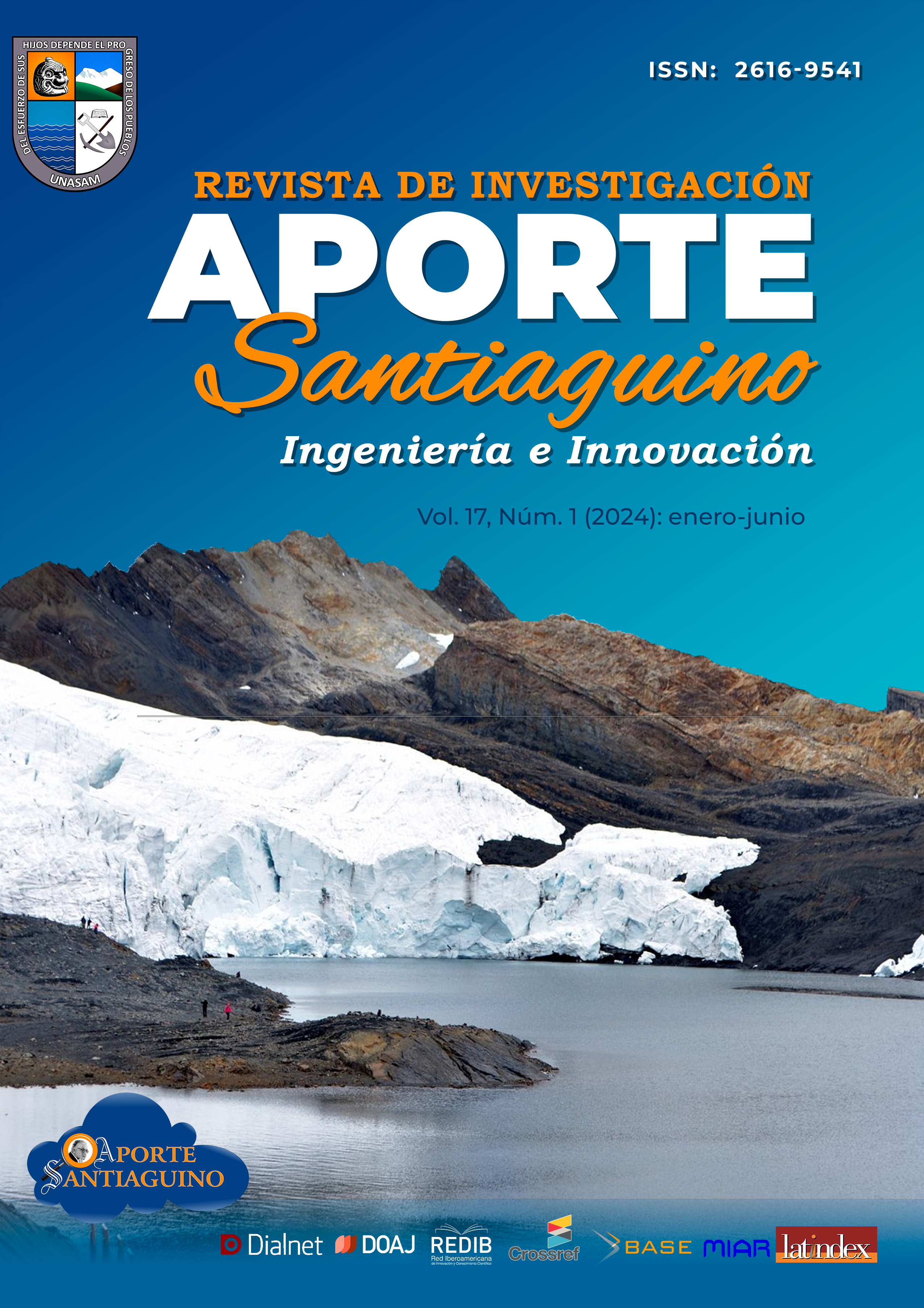Biological layer in trickling filters at different organic loads in the Andean area
DOI:
https://doi.org/10.32911/as.2024.v17.n1.1133Keywords:
Biological layer; Biofilm; Trickling filters; Microorganisms; Organic load; wastewater.Abstract
The research studies the biological layer in trickling filters, especially in the filter medium where the microorganisms that use biodegradable material develop. The objective was to evaluate the biological layer that develops in trickling filters in gravel and charcoal support medium and how it is affected by hydraulic load and organic load. Nine pilot-scale trickling filters were developed, six with charcoal support and three with gravel support, with depths of 0.08, 0.41 and 0.74 m. The results showed that the generation of the biological layer occurred from the first contact with the waste water in the filter medium. Subsequently, there was the presence and development of flagellated protozoa (Vorticella and Euglena), ciliated protozoa (Colpoda, Oxytrichia and Paramecium), rhizopods (Amoebas) and rotifers (Lecane). It is concluded that hydraulic load does affect the growth of the biological layer. Therefore, if the support has a minimum level of humidity, it can cause the fall of microorganisms and, if there is too much, the breaking of the biological layer. The organic contribution also disturbs the growth of the biological layer, since the organic matter is absorbed, allowing the microorganisms to degrade it and grow, increasing the thickness of the biofilm
Downloads
References
Alvarado Machado, G. y Guerrero Ramírez, S. (2019). Diagnóstico de infraestructura de saneamiento en el distrito Suyo-Provincia Ayabaca-Piura-Perú [Tesis de pregrado, Universidad Nacional de Piura].
Bennewitz, R..; Doris, M..; Fernández-Elgueta, K.; Guzmán-Fierro, V. y Behar-Latorre, J. (2015). Un proceso integrado de digestión anaeróbica y oxidación aeróbica/anaeróbica de amonio y desnitrificación, Snad, para producir biogas a partir de excretas avícolas.
Bhambore, N. y Suresh Kumar, M. (2022). Municipal solid waste generation, management scenarios, and leachate treatment using sequencing batch biofilter granular reactor. Process Safety and Environmental Protection, 167, 454–468. https://doi.org/https://doi.org/10.1016/j.psep.2022.09.027
Borges, C.; Rojas, B.; Novelo, R..; Rodríguez, J. y Canul, P. (2012). Remoción de materia orgánica en aguas residuales de rastro por el proceso de Contactor Biológico Rotacional. Ingeniería, 16(2), 83–91.
Espinosa-Rodríguez, M.; Ruiz-Sánchez, J.; Hidalgo-Millán, A. y Delgado-Delgado, R. (2019a). Efecto de la carga hidráulica de un filtro percolador en el proceso de nitrificación. Revista Mexicana de Ingeniería Química, 18(1), 107–113.
Espinosa-Rodríguez, M.; Ruiz-Sánchez, T.; Hidalgo-Millán, A. y Delgado-Delgado, R. (2019b). Efecto de la carga hidráulica de un filtro percolador en el proceso de nitrificación. Revista Mexicana de Ingeniería Química, 18(1), 107–113.
Garzón Zúñiga, M.; González Zurita, J. y García Barrios, R. (2016). Evaluación de un sistema de tratamiento doméstico para reúso de agua residual. Revista Internacional de Contaminación Ambiental, 32(2), 199–211.
Huamán, M.; Rosas, Y. y Depaz, K. (2022). Effect of Hydraulic and Organic Load, in the Removal of Biochemical Oxygen Demand in Wastewater using Biofilter with Vegetable Carbon, in High Andean Climate. IOP Conference Series: Earth and Environmental Science, 973(1). https://doi.org/10.1088/1755-1315/973/1/012002.
Isac, L.; Rodríguez, E.; Salas, M.; Fernández, N.; Pérez-Uz, B. y Serrano, S. (1994). Protozoos en el fango activo. Universidad Complu-Tense de Madrid, Facultad de Biología.
Jenkins, G. y Black, K. P. (2021). Modelling the effects of changing loads of nitrogen discharged from a sewage treatment plant on plankton dynamics in a large, urbanised bay. Regional Studies in Marine Science, 45, 101825.
Kornaros, M. y Lyberatos, G. (2006). Biological treatment of wastewaters from a dye manufacturing company using a trickling filter. Journal of Hazardous Materials, 136(1), 95–102. https://doi.org/10.1016/J.JHAZMAT.2005.11.018
Mahto, K. y Das, S. (2022). Bacterial biofilm and extracellular polymeric substances in the moving bed biofilm reactor for wastewater treatment: A review. Bioresource Technology, 345, 126476.
Morales-Fiallos, F.; Maldonado Narváez, L.; Nuñez-Aldás, G.; Paredes-Cabezas, G. y Hechavarría, R. (2022). Filtro con elementos de bagazo de caña de azúcar para el tratamiento de aguas residuales de lavadoras de autos en la ciudad de Ambato, Ecuador. Tecnología y Ciencias Del Agua, 13(5), 365–395. https://doi.org/10.24850/j-tyca-13-05-10.
Qu, J.; Wang, H.; Wang, K.; Yu, G.; Ke, B.; Yu, H.; Ren, H.; Zheng, X.; Li, J. y Li, W. (2019). Municipal wastewater treatment in China: Development history and future perspectives. Frontiers of Environmental Science & Engineering, 13(6), 1–7.
Rahman, Y.; Cooper, R.; Truong, N.; Ergas, S. y Nachabe, M. (2021). Water quality and hydraulic performance of biochar amended biofilters for management of agricultural runoff. Chemosphere, 130978. https://doi.org/10.1016/j.chemosphere.2021.130978.
Ramalho, R. (2021). Tratamiento de aguas residuales. Reverté.
Reyes-Lara, S. y Reyes-Mazzoco, R. (2009). Efecto de las cargas hidráulica y orgánica sobre la remoción másica de un empaque estructurado en un filtro percolador. Revista mexicana de ingeniería química, 8(1), 101-109.
http://www.scielo.org.mx/scielo.php?script=sci_arttext&pid=S1665-27382009000100010&lng=es&tlng=es
Romero, J. (2004). Tratamiento de aguas residuales, teoría y principios de diseño. Escuela Colombiana de Ingenieros.
Sato, T.; Qadir, M.; Yamamoto, S.; Endo, T. y Zahoor, A. (2013). Global, regional, and country level need for data on wastewater generation, treatment, and use. Agricultural Water Management, 130, 1–13. https://doi.org/10.1016/J.AGWAT.2013.08.007
Scott, T. y Fulton, P. (1979). Removal of pollutants in the overland flow (grass filtration) system. Progress in Water Technology, 11(4–5).
Singh, K.; Singh, R.; Rai, B. y Upadhyay, S. (2010). Biofiltration of toluene using wood charcoal as the biofilter media. Bioresource Technology, 101(11), 3947–3951. https://doi.org/10.1016/J.BIORTECH.2010.01.025.
Downloads
Published
How to Cite
Issue
Section
License
Copyright (c) 2024 Rosario Polo Salazar

This work is licensed under a Creative Commons Attribution 4.0 International License.




















